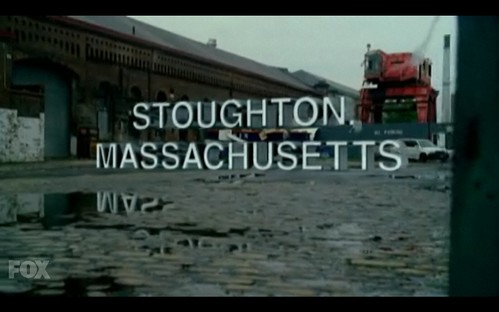-
"The camera itself will trap Harry, leaving him all the more vulnerable because he is alone." But of course. A wonderful opening to a wonderful, wonderful film; still, perhaps, my favourite film, and one so rooted in editing and film-making. The camera, constantly trapping Caul, boxing him in, is worth paying attention to, and this short description of the opening captures its predatory nature.
Text In The World
07 July 2009
After a long period underground, Ubisoft’s Splinter Cell: Conviction emerged at E3 substantially different to its previous incarnations. And whilst I, for one, am grateful for the removal of Sam Fisher’s trampy hairdo, the new feature that got me really, really excited seems to have passed with relatively little fanfare. Here it is:

Mission objectives – or, at least, reminders thereof – written into the environment, mapped over space, appearing to the player along; subjective and stylistic, but never part of a HUD. It’s classy and striking, and not something people are playing with in games nearly enough. Prior to this, easily my favourite type design in games came from Codemasters’ GRID:

which placed text into the world as first-class 3D objects, and let the player spin and pivot the camera around it, as if to emphasise both its subjectivity and genuine 3D-ness.
But this has been a thing in movies and TV for a while, now. Here’s JJ Abrams’ Fringe:

which even nails the reflections in the water. And, of course, one of the earliest points of reference for this in genuine 3D is David Fincher’s Panic Room:

which, as Ben has pointed out, owes a great debt to Saul Bass’ titles for North by Northwest:

which makes quite a nice list.
-
"Even the platform holders are excited about the potential for social networking to tie into games. At E3, Microsoft proudly announced integration of Facebook, music network Last.fm and Twitter with Xbox Live. The latter pair are fairly irrelevant, admittedly. Last.fm is solely a music service, while Twitter isn't actually a social network at all – it's a one-to-many broadcast system, which isn't quite the same thing." Oh. But that's where you're wrong, Rob. Sorry.
-
'“The degree to which you can engage your customer base in creating value for your other players” is key, says Newell. “When people say interesting or intelligent things about your product, it will translate directly into incremental revenue for the content provider.”' Masses of good things in here – think I've quoted it elsewhere – but it's not on my Delicious, so in it goes.
-
"DFC's main takeaway from the study is that the flexible, quickly-adaptable nature of online distribution services like Steam allow for developers to use a broad variety of promotions and incentives to keep their game communities fresh; individual promotions like the Survival Pack had a positive effect on both platforms, but it was the one-two punch of that DLC plus the followup free weekend through Steam that had the most meaningful impact on the game at any point on either platform."
-
Art of the Title interview the chaps behind Wall-E's end credits, which knocked me out the first time I saw them, and still give me the loveliest buzz to this day.
-
Generates a tiny file to do the most basic things, from the looks of it.
-
"Pretty sure I'm not the first person in the universe to come up with this idea, but I've yet to see another connect-the-dots tattoo." Beautiful.
-
"It’s somewhat embarrassing, but that’s how I got into economics: I wanted to be a psychohistorian when I grew up, and economics was as close as I could get." Paul Krugman, you are the best.
-
"The Theory of Interstellar Trade is a paper written in 1978 by economist Paul Krugman…. Krugman analyzed the question of 'how should interest rates on goods in transit be computed when the goods travel at close to the speed of light? This is a problem because the time taken in transit will appear less to an observer traveling with the goods than to a stationary observer.'" Paul Krugman, winner of the 2008 Nobel Prize for Economics, is officially awesome.
-
"The New York Times Magazine food issue had plenty of fun this weekend; Looks like photo editor Kathy Ryan gave photographer Martin Klimas a 22-caliber rifle and told him to embrace his anger. He decimated an ear of corn, an apple and a pumpkin so thoroughly that the editors could not decide on a favorite." Beautiful.
-
Strategy game that requires you to work within the boundaries of limited – but potentially powerful – AI, and act as a guiding "real intelligence" for your ships.
-
"Brownjohn had never worked with live action before, nor had his animation assistant Trevor Bond. Using techniques taught by László Moholy-Nagy, Brownjohn's team beamed light over three separate models; a belly dancer, a snake dancer and a model for close-ups." Short blogpost – with archive behind-the-scenes images – on creating the title sequence for Goldfinger.
-
"LittleBigPlanet lets [players] run wild, with unprecedented results, but it locks the majority out of the creative process, because it's time-consuming and simply not very enjoyable. We hoped it could do both those things. That it doesn't isn't the let-down it might have been, thanks to the untamed community of brilliant nutjobs that's already out there, appending their DIY masterpieces to this beautiful, mildly flawed, magnificently multiplayer platform game. We salute them, we salute Media Molecule for making it possible for them, and we salute Sony for its total commitment to this brave, hare-brained project. But mostly, we're just happy to see a flagship game for a modern system that's about running from left to right and jumping over things."